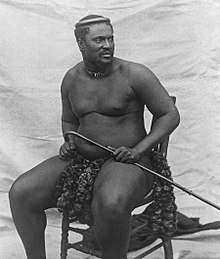Battle of Ndondakusuka
The Battle of Ndondakusuka (2 December 1856) was the culmination of a succession struggle in the Zulu kingdom between Cetshwayo and Mbuyazi, the two eldest sons of the king Mpande. The latter was defeated at the battle and was killed, leaving Cetshwayo in de facto control of the kingdom, though his father remained king. All of Mbuyazi's followers were massacred in the aftermath of the battle, including five other sons of the king.
| Battle of Ndondakusuka | |||||||
|---|---|---|---|---|---|---|---|
| Part of Zulu Civil War | |||||||
 Cetshwayo, the battle's victor | |||||||
| |||||||
| Belligerents | |||||||
| Cetshwayo faction (uSuthu) | Mbuyazi faction (iziGqoza) | ||||||
| Commanders and leaders | |||||||
| Cetshwayo |
Mbuyazi John Robert Dunn | ||||||
| Strength | |||||||
| c. 20,000 | c. 7,000 | ||||||
| Casualties and losses | |||||||
| unknown | over 20,000 (including non-combatants) | ||||||
Background
Cetshwayo was the eldest son of the King Mpande kaSenzangakhona. Many of the izikhulu supported Cetshwayo but Mpande favoured his next eldest son Mbuyazi. Previous kings had succeeded to the throne through bloody means and Mpande’s successor would face the same trial.
Mbuyazi was Mpande’s second son by a widow of the great Zulu king Shaka. The higher status was Mpande’s justification that the elder Cetshwayo should be bypassed. At a sacrifice of an ox, the point was made known when Mpande ordered that the shields to be made from the hide would have the best side used for Mbuyazi. An induna pointed out to Mpande that this meant he was renouncing Cetshwayo as rightful heir. Mpande retorted that when he was a commoner he had fathered Mbuyazi on the behalf of Shaka and that now as king the significance of that birth would be recognized by being Mpande's successor. The public consequences of that action were realized when Mpande ordered Mbuyazi to move his supporters, the iziGqoza faction, to the south of the Mhlatuze River, the area that as the first son had been occupied by Cetshwayo and his followers, the uSuthu faction. Cetshwayo believed that it was the time to act decisively and mobilised his forces. He intended to remove this threat to his succession to the Zulu kingship.
Forces Involved
Mbuyazi had far fewer supporters than Cetshwayo. On the advice of his father, he sought help from white settlers in Natal led by John Dunn. Dunn gathered a small group of 35 Natal Border Police and an additional force of 100 native hunters. Mbuyazi's own forces totaled 7,000 warriors. Cetshwayo was seen by many as the rightful heir, so warriors flocked to his support, which numbered between 15,000 and 20,000 men. The guns of the colonials could only help Mbuyazi up to a point, as their numbers were too few to overcome such a large enemy force, but he was not discouraged. Mbuyuzi remembered that Mpande's general Nongalaza had overcome a superior force during the Battle of Maqongqo against Dingane. Nongalaza himself joined Mbuyazi at Mpande's request.[1]
The battle
Mbuyazi's forces had their backs to the Zulu Kingdom's border along the bank of the Tugela River, the latter filled by the seasonal rains that swelled the river into a torrent. Mbuyazi had his warriors burn a line in the grass which would serve as a marker of no further retreat as they pledged to win, and if not die on the field.
Cetshwayo's first attack failed, giving heart to the Mbuyazi forces after they repelled it. But Cetshwayo had enough reserves for a second attack. Cetshwayo's inner circle of supporters were then sent in, along with the Mandlakazi who far outnumbered the iziGqoza. Mbuyazi's army was overwhelmed. Mbuyazi and five of his siblings were killed. Others were swept away by the river when they attempted escape. Mpande's aging general Nongalaza, barely swam to safety.[1]
John Dunn and his forces were to the left of Mbuyazi’s and escaped by means of a boat waiting on the Natal boundary of the river; it was said that escaping Mbuyazi forces were refused a place on the boat. Very quickly, the battle turned into the slaughter of all Mbuyazi’s surviving followers.
Aftermath
In the aftermath of the battle the uSuthu faction slaughtered, with their assegais, every iziGqoza they could find, including the women and children. The justification for this act was that women bore warriors and children grow up. It is estimated that 20,000 people were killed and the mouth of the Tugela river where the bodies washed up began to be referred to as the Mathambo ("place of bones")[2]
John Dunn later negotiated with Cetshwayo for the return of settler property captured after the battle. He later became an important advisor to Cetshwayo and an influential intermediary between the Zulus, Boers and British.
Mpande was inconsolable and resentful, and when Cetshwayo presented all the captured iziGqoza cattle to his father, Mpande refused and ordered Cetshwayo to leave. He left without any retaliation to the rejection and bided his time until the natural death of his father then was crowned king by Theophilus Shepstone (1 September 1873 ).
References
- Labland, John, Historical Dictionary of the Zulu Wars, Scarecrow Press, 2009, p.201
- Knight, Ian (1995) The Anatomy of The Zulu Army: From Shaka to Cetshwayo, Greenhill Books London.
Sources
- Taylor, Stephen (1994) Shaka’s Children. Harper Collins London.
- Knight, Ian (1989) The Zulus. Osprey, London.